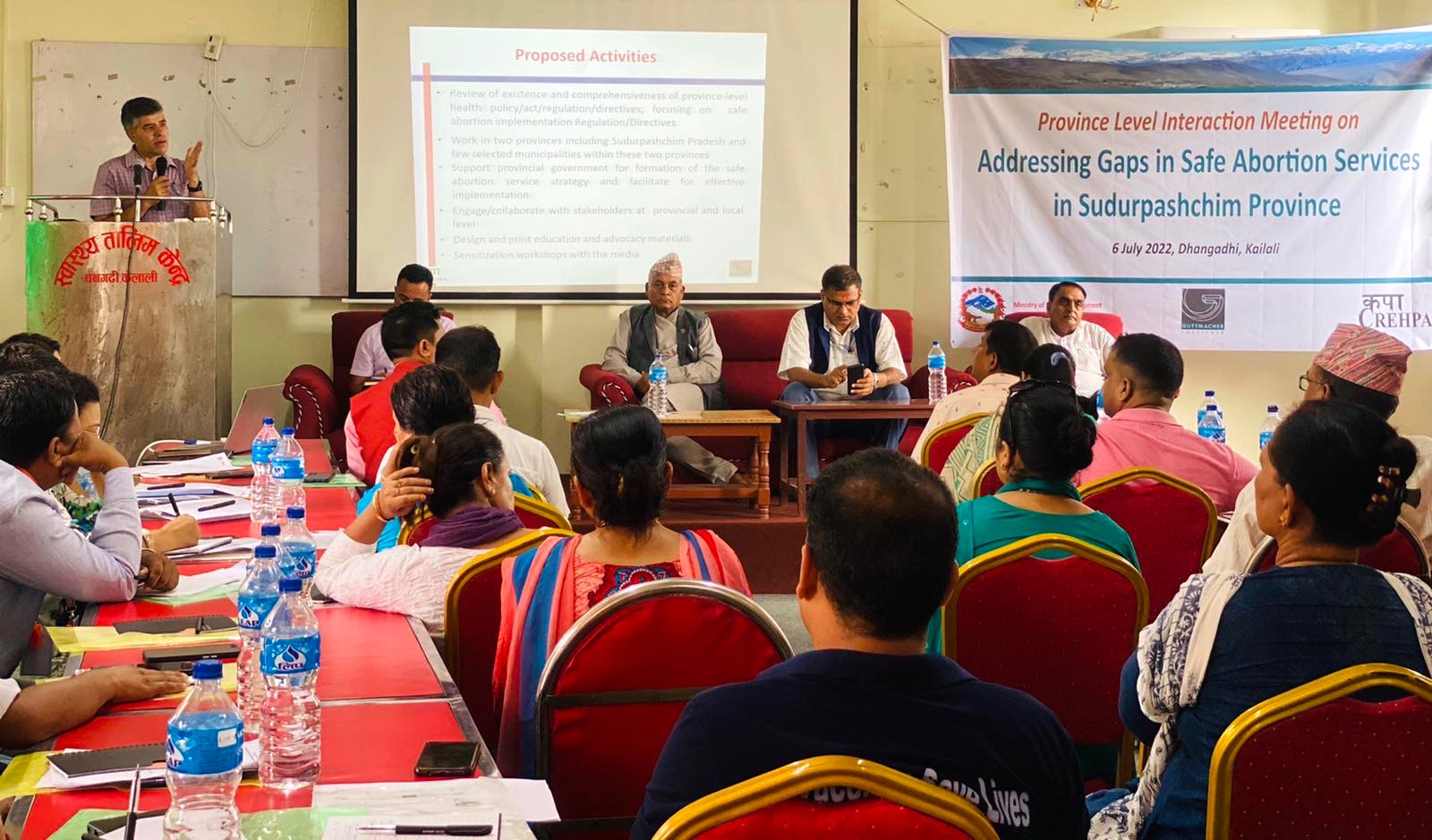This report is published in partnership with the Center for Research on Environment, Health and Population Activities (CREHPA).

The Advocacy Case Study series provides practical examples from different country contexts of policy or programmatic efforts to advance sexual and reproductive health and rights. By describing the rationale for the actions taken, evidence used, any progress achieved and recommended next steps, these cases illustrate advocacy efforts to achieve specific outcomes, offer useful guidance, and spur new thinking and strategies.
By amending its National Code in 2002, Nepal moved from completely prohibiting abortion to allowing it on request,1 something that no other country in South Asia has done in a single stroke. As with any expansion of legal grounds, effective reform requires meaningful efforts to ensure access, and the country is notable for that too: Nepal’s 2018 Right to Safe Motherhood and Reproductive Health Act enshrines in national law the right to safe abortion services free of charge in public facilities.2 Enabling all women throughout the country to exercise that right, however, remains a challenge.3
For example, nearly three-fifths of abortions (58%) occur outside of approved facilities, which indicates a gap in access to quality clinical care.4 These potentially unsafe abortions contribute to Nepal’s maternal mortality ratio of 151 maternal deaths per 100,000 live births.5 The need for safe abortion care is not going away: Thirty-five percent of married women of reproductive age have an unmet need for modern contraception,6 leading to 64 unintended pregnancies occurring each year per 1,000 women aged 15–49.7
| Selected reproductive health indicators | ||
| Nepal | Sudurpashchim Province | |
| No. of women (2017) | 8,450,000 | 815,000 |
| Maternal mortality ratio (no. of maternal deaths per 100,000 live births, 2021) | 151 | 130 |
| Abortion rate (no. per 1,000 women, 2017) | 42 | 21 |
| Unintended pregnancy rate (no. per 1,000 women, 2017) | 64 | 44 |
| % of married women with unmet need for modern contraceptive methods (2022) | 35 | 34 |
| % of pregnancies unintended (2017) | 45 | 39 |
| % of unintended pregnancies ending in abortion (2017)* | 65 | 47 |
| % of unintended pregnancies ending in unplanned births* (2017) | 24 | 40 |
| *% of unintended pregnancies ending in miscarriage not shown. Notes: "Women" refers to women of reproductive age (15–49). Data cited are the most recent available. Sources: References 5–7. |
||
In 2015, Nepal adopted a new constitution and with it a restructured health system that delegated health care delivery to federal, provincial and local (i.e., municipal) governing bodies.8 Transitioning most of the delivery of care to province and local governments represented a major shift. For abortion care in particular, the health system reorganization meant that all seven provinces had to consider how to best adapt and implement the existing national-level comprehensive abortion care implementation guidelines.9
Nepal needed a roadmap on how to devolve care to provincial and local levels. This case study describes an advocacy initiative to adapt national safe abortion guidelines so that they could be implemented by province- and local-level governments. We summarize its outcome as a resource for other provinces in Nepal—and potentially for other countries that have decentralized their health systems or just need abortion care guidelines tailored for local use.
Identifying the Need for Province-Specific Guidelines
As a first step, in June 2022, the national organization Center for Research on Environment, Health and Population Activities (CREHPA) hosted a meeting in Kathmandu with an array of national-level stakeholders in sexual and reproductive health and rights to expand the evidence base for advocacy. On the agenda were ways to improve the quality of safe abortion care, expand its delivery into remote locations, implement the no-fee policy in public facilities and remove the bottlenecks created by frequent stockouts of medication abortion drugs.
CREHPA presented a review of gaps in services that highlighted the need for province- and local-level guidelines to improve safe abortion services within the new federalism adopted by the country. Participants concurred on the need to develop local safe abortion guidelines and the main steps for doing so. Two of Nepal’s seven provinces—Madhesh and Sudurpashchim—were suggested by national-level stakeholders as likely candidates for this work.
Selecting the Province
Of those two provinces, Sudurpashchim was identified as the best first candidate for adapting the existing abortion care guidelines to comply with the country’s move to federalism. As of 2017, the estimated proportion of unintended pregnancies ending in unplanned births was nearly twice as high in Sudurpashchim as in the country overall: Forty percent of unintended pregnancies there ended in unplanned births, compared with the national average of just 24%.7 This implied that the unmet need for safe abortion was higher than average in the province, a situation likely stemming from services being much less available than they should be. In 2022, almost one-quarter of abortion provision sites in the province were nonfunctional, as were five out of six sites designated as sources of second-trimester services.10
In July 2022, CREHPA held a second meeting, in Sudurpashchim, with province-level stakeholders, including the Sudurpashchim minister and the secretary of the Ministry of Social Development (the ministry responsible for health in this province). At this meeting, after CREHPA’s presentation on gaps in safe abortion services, Sudurpashchim’s chief of Public Health Section at the Ministry of Social Development summarized progress in, and remaining challenges to, delivering safe abortion in the province specifically. The province already suffered from frequent stockouts in abortion commodities, insufficient training sites, and a lack of regulatory and accountability mechanisms. Because of the health-system restructuring, staff had transferred out of the province, resulting in service disruptions. The situation in Sudurpashchim created a sense of urgency to address these interconnected problems and reaffirmed the need for province-level guidelines. A consensus quickly emerged on the need to clarify the confusion created by the new roles and responsibilities of each administrative tier—federal, province and local.

CREHPA formed a technical advisory committee, under the leadership of Sudurpashchim's chief of Public Health Section at the Ministry of Social Development. Committee members included representatives from the Sudurpashchim Ministry of Social Development, the United Nations Population Fund, Marie Stopes International, Ipas, the Family Planning Association of Nepal, the Nepal Health Sector Support Programme and the Sudurpashchim Health Directorate.
CREHPA engaged a former director general of the Department of Health Services, Ministry of Health and Population, who was a resident of Sudurpashchim Province and highly respected, to provide technical support to the committee. This official was a leader in the health sector, having served in key posts within the Ministry, and was instrumental in legalizing abortion in Nepal. His involvement sped up the process immeasurably.
Drafting the Guidelines
With support from CREHPA, the technical advisory committee initiated drafting the province-level guidelines. The committee’s approach was to hold local views paramount throughout the entire process, respecting the local community and considering its strengths and needs. In addition, many province-level stakeholders reviewed each successive draft of the guidelines to ensure that as many relevant players as possible would propose feedback, see its incorporation into the draft and sign off on the final version. Frequent changes in senior government staff, at both province and local levels, and the sometimes low priority given to safe abortion slowed the process at times. To keep things moving, the CREHPA team regularly requested in-person meetings with decision makers and stayed in contact with advocates at all levels.
At the end of this collaborative and iterative process lasting just over three months, the final draft was submitted for approval. Nepal’s elections delayed the expected approval of the guidelines; as of this writing, they are awaiting sign-off by the minister of Social Development of Sudurpashchim Province, who has yet to be appointed by the chief minister of the province.
Recommendations for Success
All countries can benefit from local implementation guidelines to ensure that abortions are done as safely as possible. For countries that restrict abortion, guidelines are still needed for those abortions that meet legal criteria. In these settings, guidelines for quality postabortion care, free from punitive reporting requirements, are also essential to save lives—as restrictive laws often leave women reliant on unsafe methods of abortion. Even better, broadening legal grounds would greatly reduce unsafe abortions to begin with.
Advocates in other settings may be able to replicate the progress made in Sudurpashchim Province by focusing on the following strategies:
-
Use research evidence and analyses of trend data (national and subnational)—on topics such as contraceptive use, abortion, and the extent to which unintended pregnancies end in abortion or unplanned birth—to inform interventions at all government levels.
-
Present key points on achievements and gaps in provision of services at province or relevant government levels, to explain why level-specific guidelines are needed.
-
Rely on local officials who know the terrain and context best. Doing so ensures that they have the sense of ownership needed to adapt national guidelines to local environments.
-
When possible, engage a well-connected and respected local champion to liaise with province- and national-level stakeholders and promote the local perspective.
-
Collaborate with NGOs and government agencies to benefit from their respective expertise and authority to make policy.
-
Participate in successive rounds of feedback with as many stakeholders as possible, from the most relevant local ministry or policymaking agency.
-
Ensure that implementation guidelines contain the structural means for accountability at the province and local levels.
References
1. Government of Nepal, 11th Amendment to the Muluki Ain (National Code) of Nepal, 1959 (2020 BS), 2002, https://nepal.ohchr.org/en/resources/Documents/English/other/2009/March%2009/1.Country%20Code%20amendment.pdf.
2. Nepal Law Commission, Government of Nepal, The Right to Safe Motherhood and Reproductive Health Act, 2018 (2075 BS), Act No. 9, https://nepal.unfpa.org/sites/default/files/pub-pdf/The%20Right%20to%20Safe%20Motherhood%20and%20Reproductive%20Health%20Act%202075.pdf.
3. Puri M, Tamang A and Singh S, Addressing Gaps in Safe Abortion Services in Nepal, New York: Guttmacher Institute; and Kathmandu, Nepal: Center for Research on Environment, Health and Population Activities (CREHPA), 2022, https://www.guttmacher.org/article/2022/06/addressing-gaps-safe-abortion-services-nepal.
4. Puri M et al., Abortion incidence and unintended pregnancy in Nepal, International Perspectives on Sexual and Reproductive Health, 2016, 42(4):197–209, doi:10.1363/42e2116.
5. Ministry of Health and Population and the National Statistics Office, National Population and Housing Census 2021: Nepal Maternal Mortality Study 2021, Kathmandu, Nepal: Ministry of Health and Population and National Statistics Office, 2022, https://mohp.gov.np/uploads/Resources/Nepal%20Maternal%20Mortality%20Report%202021.pdf.
6. Ministry of Health and Population, New ERA and ICF International, Nepal Demographic and Health Survey 2022: Key Indicators Report, Kathmandu, Nepal: Ministry of Health and Population, 2022, https://dhsprogram.com/pubs/pdf/PR142/PR142.pdf.
7. Sundaram A et al., Adding It Up: Costs and Benefits of Meeting the Contraceptive and Maternal and Newborn Health Needs of Women in Nepal, New York: Guttmacher Institute, 2019, https://www.guttmacher.org/report/adding-it-up-meeting-contraceptive-mnh-needs-nepal.
8. Government of Nepal, Constitution of Nepal, 2015, https://constituteproject.org/countries/Asia/Nepal?lang=en.
9. National Health Training Centre, Department of Health Services, Ministry of Health and Population, Comprehensive Abortion Care (CAC): Integrated Reference Manual, 3rd Ed., Kathmandu, Nepal: Ministry of Health and Population, 2015.
10. CREHPA, Status of Safe Abortion Services in Sudurpashchim Province, slide deck presentation, July 2022.
